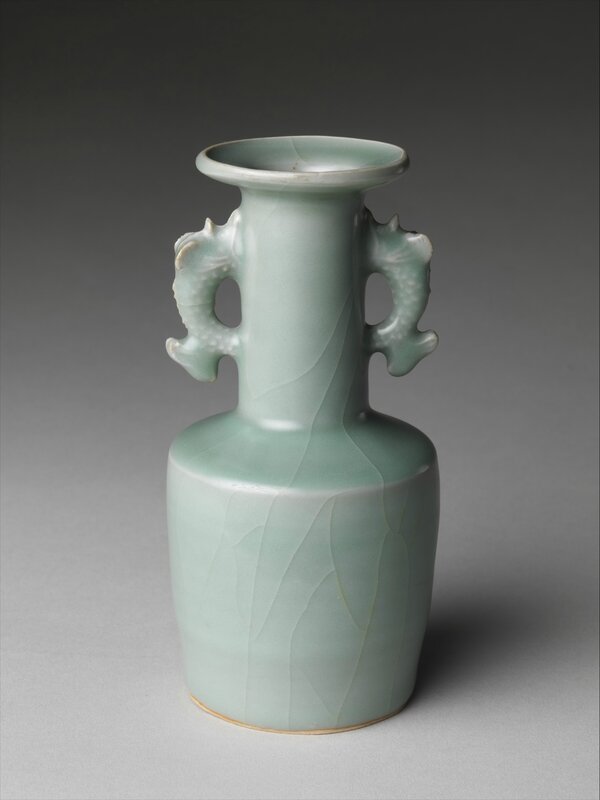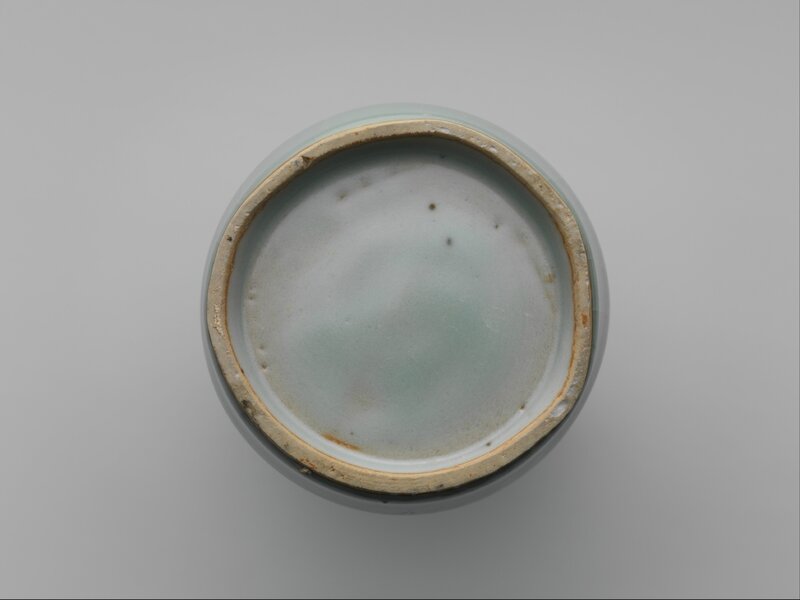Vase with Dragonfish Handles, 12th–13th century, Southern Song dynasty (1127–1279)
Vase with Dragonfish Handles, 12th–13th century, Southern Song dynasty (1127–1279).Porcelain with relief decoration under celadon glaze (Longquan ware). H. 6 3/4 in. (17.1 cm). Bequest of Mary Stillman Harkness, 1950, 50.145.301 © 2000–2016 The Metropolitan Museum of Art.
Vases of this type were especially popular in Japan, where they were sometimes used in the tea ceremony. The vase’s form, known as a mallet shape, can be traced to glass vessels produced in Syria in the ninth and tenth century and was most likely introduced to China at around that time. The fanciful handles are a Chinese addition.
To connoisseurs of Chinese ceramics, the word celadon brings to mind first and foremost the luscious glazes of the porcelaneous stonewares that were produced in the Longquan kilns of Zhejiang Province during the Southern Song period. These wares are the triumphant conclusion of a tradition of high-fired green glazes that began in the Shang dynasty (ca. 1600–1050 B.C.)—glazes that were corrected and improved upon through the centuries as though countless generations of potters were all striving toward the common ultimate goal of a glaze such as this. The form of this mallet-shaped vase has been simplified in the interests of a jadelike glaze that almost begs to be touched. Its streamlined shape is underscored by the contrast of two crisply molded fish that serve as handles.

/https%3A%2F%2Fprofilepics.canalblog.com%2Fprofilepics%2F1%2F0%2F100183.jpg)
/https%3A%2F%2Fstorage.canalblog.com%2F03%2F02%2F119589%2F96711876_o.jpg)
/https%3A%2F%2Fstorage.canalblog.com%2F11%2F31%2F119589%2F94773502_o.jpg)
/https%3A%2F%2Fstorage.canalblog.com%2F20%2F83%2F119589%2F94772815_o.jpg)
/https%3A%2F%2Fstorage.canalblog.com%2F26%2F72%2F119589%2F75604929_o.jpg)
/https%3A%2F%2Fstorage.canalblog.com%2F59%2F60%2F119589%2F26458628_o.jpg)







/http%3A%2F%2Fstorage.canalblog.com%2F76%2F98%2F119589%2F129048212_o.png)
/http%3A%2F%2Fstorage.canalblog.com%2F13%2F75%2F119589%2F129042229_o.png)
/http%3A%2F%2Fstorage.canalblog.com%2F02%2F43%2F119589%2F126917236_o.jpg)
/http%3A%2F%2Fstorage.canalblog.com%2F38%2F46%2F119589%2F126901696_o.jpg)